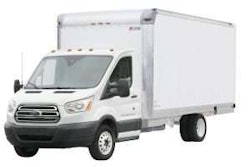Bendix Commercial Vehicle Systems LLC has introduced its next-generation of the Bendix family of integrated advanced safety technologies and is addressing the path to highly automated commercial vehicles. The next-gen products include the Wingman Fusion, BlindSpotter and Intellipark electronic parking brake, according to an announcement.
Wingman Fusion
The newest generation of Bendix Wingman Fusion adds highway departure braking, ACB (active cruise with braking) Stop & Driver Go, ACB Auto-Resume and multi-lane emergency braking to its features, along with even more enhanced collision mitigation and braking capabilities.
“Fusion continues to build on the combination of proven technologies paving the way toward an increasingly automated future of safer vehicles and roadways,” says Fred Andersky, Bendix director of customer solutions, controls. “Brake sensors, cameras and radar units all provide different, valuable types of information, all of which are combined and cross-checked to create a detailed and accurate data picture.”
A number of the new features of Wingman Fusion are the result of software advancements, so current system users will be able to upgrade and unlock the new capabilities without having to purchase new hardware. In the future, the new generation of Bendix BlindSpotter will see integration into the Wingman Fusion system, as with other sensors and safety technologies, such as steering and park brake control.
The enhancements enable Fusion to now provide full braking power on the tractor, compared with the two-thirds power previously possible, along with pulsing air back to the trailer to provide trailer braking, whether or not the trailer has an ABS/TRSP unit. Combined with improved sensor and data analysis, this means that in many emergency situations, the system can reduce a vehicle’s speed by as much as 50 miles per hour.
With the new multi-lane automatic emergency braking feature, if Fusion is applying the brakes due to a vehicle in the lane ahead and the truck driver switches to an adjacent lane, the system will continue applying the brakes if it detects another car ahead in the new lane, helping the driver avoid both the first and potentially second situation, something that can occur when multiple lanes of traffic are blocked on a highway.
ACB Stop & Driver Go is a low-speed approach to adaptive cruise control for traffic situations. It enables the driver to resume cruise control after braking to a stop without the need to push the resume switch.
The ACB Auto-Resume functionality reengages cruise control after Fusion brakes the vehicle above a certain speed threshold. Today, if the system brakes, the cruise control disengages. With ACB Auto-Resume, a feature of Bendix’s next-generation Fusion system, a driver won’t have to resume cruise if the system brakes and certain parameters are met.
Advancements within the system’s programming improve on Fusion’s ability to recognize potential problems sooner, intervene earlier and further reduce false alerts and interventions, enhancing its collision mitigation capabilities. Collision mitigation is also improved with the increase in tractor brake application potential, helping to slow the vehicle more safely and effectively.
The data provided by Wingman Fusion, generated by the brake sensors, camera and radar, is particularly valuable to a fleet’s back office. The SafetyDirect by Bendix CVS web portal, is available to capture that data and then, using a fleet’s telematics system, automatically transmit driver performance and event-based information, including video.
Most major North American truck brands offer Fusion as standard on their highway tractors, including Kenworth Truck Company, Peterbilt Motors Company, and Mack Trucks. Volvo Trucks North America offers Volvo Active Driver Assist, which is based on Wingman Fusion, as standard on its VNL and VNR series tractors. Fusion also is offered as standard on the Kenworth T680, Peterbilt Model 579 and the Mack Anthem. On Navistar’s International highway tractors, Fusion is an option over the standard Wingman Advanced™ system, according to the announcement.
BlindSpotter side object detection system
The BlindSpotter features an upgraded radar unit and the ability to integrate with the Wingman Fusion.
“Based on the input we’ve gotten from fleets using BlindSpotter over the past decade, these are the two most impactful updates Bendix could have made to a system that’s already generated a lot of positive responses about its performance,” says Andersky. “Particularly in recent years, there has been high interest in tying the side-radar unit into active safety systems as adoption rates of both have increased.”
BlindSpotter uses a new side-mounted radar unit to alert drivers to vehicles or objects in adjacent lanes. When connected to the vehicle’s J1939 CAN (controller area network), its new radar operates over a significantly wider field of view than the previous version, allowing it to “see” farther toward both the front and back of a combination or single-unit vehicle — up to 2.5 times farther in each direction compared with the previous generation of BlindSpotter. Despite the new internals, radar and CAN connectivity, the new BlindSpotter maintains the look, size, position and mounting hardware of its radar and in-cab display units, making it easy to upgrade from the current version or retrofit the entire kit.
When connected to the vehicle’s CAN, the new BlindSpotter provides a wider, 150-degree range of coverage capable of detecting objects up to 20 ft. in front of and 20 ft. behind the BlindSpotter radar. The coverage zone extends up to 10 ft. to the right of the vehicle. BlindSpotter minimizes false alerts by operating in two modes: highway speeds and lower speeds. When connected to the CAN and at highway speeds, the sensor filters out stationary objects like guardrails; the slow-speed warning mode — active at less than 20 mph, such as during city driving or in parking lots — narrows the range for alerts and does not filter out stationary targets or infrastructure.
Intellipark
Bendix Intellipark electronic parking brake control is now moving into fleet trials with an expected launch in 2019, according to the company.
Intellipark helps prevent rollaway and runaway crashes by automatically setting the brakes if the driver exits the vehicle while it is not parked. Beyond rollaway mitigation, the system uses information available on the vehicle network to allow the park brake to be released only when an authorized driver is in full control of the vehicle. Intellipark also delivers features such as Trailer Auto-Park Release, which can automatically release trailer brakes when the vehicle is moving. The Park-at-Speed feature helps the driver to maintain control if the parking brakes are applied while driving. Plus, the system delivers a more durable and ergonomic interface.
Because Intellipark is electronic, it is also positioned for integration with Bendix Wingman Fusion, enabling the use of the parking brakes to further enhance driver assistance functions. In addition, it delivers the parking functions necessary for future autonomous vehicles.
Bendix engineered Intellipark for use with any air-braked vehicle, including tractor-trailers, single-unit trucks, motorcoaches and school buses. It’s designed to help drivers mitigate a variety of unsafe situations, as well as deliver a quick ROI to the fleet through incident prevention and a longer life with minimal maintenance.
Intellipark features an improved, driver-friendly interface that eases the effort of setting the parking brake, replacing the red and yellow push/pull knobs with switches that can be flipped on and off. The switches display the familiar red and yellow symbols and they activate the parking brake through less physical effort on the driver’s part. This enhanced ergonomic design may also help decrease driver fatigue and prevent repetitive motion injuries. And the easy-to-read interface, which includes LED lights, helps the driver understand the status of the parking brakes on both the tractor and the trailer prior to leaving the vehicle or heading out on the road.
If the driver misses the LED indication on the user interface or the Trailer Air Warning telltale on the vehicle instrument cluster and begins to drive away with the trailer park brake engaged, Intellipark’s Trailer Auto-Park Release will disengage the trailer park brake automatically. This helps reduce the chance for trailer tire flat-spotting, trailer tire fires, and wheel-end damage.
“Fleets can use data provided by Intellipark to help gain insight when the system activates to set the parking brake automatically, or to disengage the trailer brakes automatically. For fleets equipped with the web portal SafetyDirect by Bendix CVS, that data is transmitted through their telematics provider automatically to fleet offices,” Andersky says.










